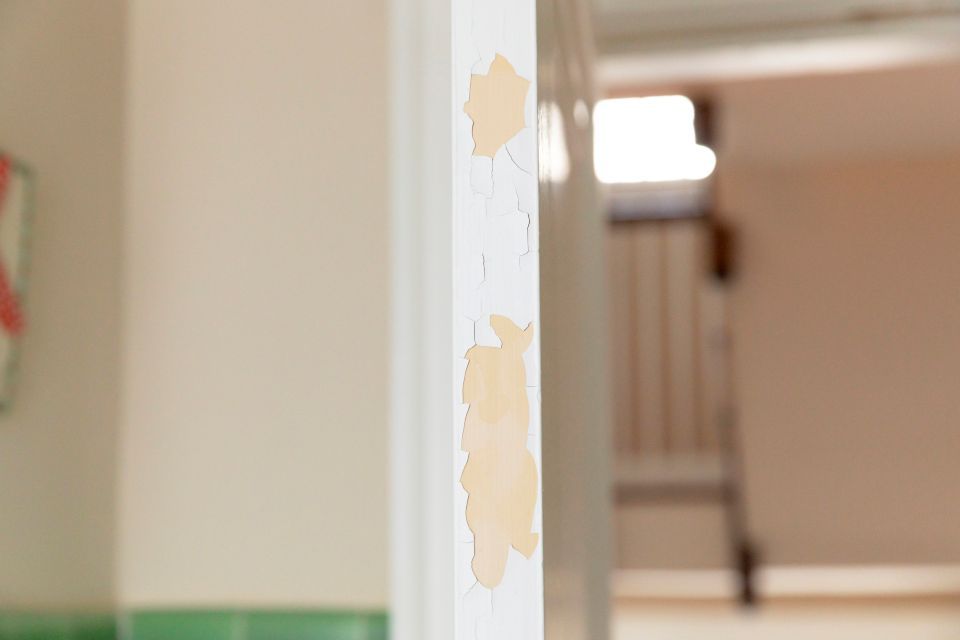Why Your Paint is Peeling (and How to Fix It Before Repainting)
Few things make a home look more neglected than walls with peeling or flaking paint. Whether it’s your living room, bathroom, or the exterior of your home, paint that’s bubbling, cracking, or literally falling off the wall is not just an eyesore — it’s a sign that something has gone wrong.
This issue can affect both interior and exterior walls, and while it may look purely cosmetic, it can signal bigger problems with moisture, surface preparation, or paint quality.
The good news is, with the right approach, peeling paint can be fixed. Before you repaint, it’s important to understand why paint fails, how to
prepare the wall properly, and what steps you can take to ensure your new finish lasts.
Why Paint Peels or Flakes Off Walls
When paint begins to peel off a wall, it means the bond between the surface and the paint layer has broken. Several factors can cause this.

- Poor Surface Preparation. Paint needs a clean, stable base. If walls were painted over dust, grease, or flaking old paint, the new coat won’t adhere properly.
- Pro: Quick fixes are possible if caught early.
- Con: Once adhesion fails, large areas may need stripping.
- Moisture Problems. Excess moisture is one of the biggest culprits. Bathrooms, laundries, kitchens, and exterior walls exposed to rain or rising damp are especially prone. Moisture gets trapped behind the paint, causing it to bubble and peel.
- Pro: Identifying leaks early can save structural damage.
- Con: Moisture repairs can be costly if plumbing or drainage issues are involved.
- Wrong Type of Paint. Interior paints used on exterior walls, or mismatched paint systems (oil over latex, for example), will eventually peel.
- Pro: Modern paint ranges are labelled clearly for easy selection.
- Con: Repainting with the wrong product often means doing the job twice.
- Skipping Primer. Primer acts as a bonding layer, particularly on new plaster, timber, or masonry. Without it, paint has little to grip onto.
- Pro: Primers are inexpensive and improve durability.
- Con: Adds an extra step and time to the job.
- Age and Weathering. Even the best paint breaks down over time. Perth’s hot summers and UV exposure accelerate this process, leading to chalking, cracking, and peeling.
- Pro: Repainting renews your home’s look and protection.
- Con: Exterior repainting requires ladders, scaffolds, and safety gear.
How to Fix Peeling Paint on Walls
Fixing peeling paint is not just about patching up the surface. If you want your repaint to last, you need to follow a methodical process.
Step 1: Identify and Fix the Cause
Before sanding or priming, ask yourself: why did the paint peel in the first place? If moisture is the issue, repair leaks, improve ventilation, or install exhaust fans. If it’s poor surface prep, commit to stripping and cleaning thoroughly.
- Pro: Solving the cause prevents the same problem happening again.
- Con: Root causes like dampness may require professional repairs.
Step 2: Remove Loose Paint
Using a paint scraper, wire brush, or even a heat gun for stubborn spots, strip away any flaking paint. Sand edges smooth to blend with surrounding areas.
- Pro: Creates a stable surface for new paint.
- Con: Labour intensive, especially for larger areas.
Step 3: Clean the Surface
Wash the wall with sugar soap or mild detergent to remove dirt, dust, and grease. Rinse and allow the surface to dry completely.
- Pro: Ensures maximum adhesion of primer and paint.
- Con: Drying time can delay progress.
Step 4: Apply Primer
Choose a primer suited to the surface (plaster, timber, masonry) and problem (stain-blocking, moisture-resistant, etc.). Apply one even coat and allow it to cure fully.
- Pro: Extends paint life and improves adhesion.
- Con: Adds an extra day to the project.
Step 5: Repaint
Select high-quality paint designed for interior or exterior use, depending on where the wall is. Apply at least two coats with a roller or brush for even coverage.
- Pro: Professional-grade paints resist peeling, cracking, and fading.
- Con: Premium products cost more, but save money long-term.
Peeling Paint on Ceiling
Ceilings are especially prone to paint failure because they often trap heat, moisture, and condensation. Bathrooms, kitchens, and laundries are the most common problem areas, but even living room or bedroom ceilings can suffer if the original surface wasn’t primed properly or if low-quality paint was used.
To fix peeling paint on a ceiling, start by scraping away all loose or flaking paint with a scraper or putty knife. Sand the area to smooth the edges and create a stable base. Wash the surface with sugar soap to remove dust and grime, then apply a stain-blocking or moisture-resistant primer before repainting with ceiling paint. If water leaks from a roof or upstairs bathroom caused the damage, make sure the source of the moisture is repaired before painting again — otherwise, the peeling will quickly return.
For a long-lasting finish, always use high-quality ceiling paint that resists mould and moisture. In wet areas, improving ventilation with an exhaust fan or vent will also help prevent ceiling paint peeling in the future.
How to Prevent Paint Peeling in the Future
Fixing peeling paint is only part of the job. Preventing it from happening again is the real goal. Here are key tips:
- Prepare properly: Always scrape, sand, and clean before painting.
- Use the right paint: Choose products suited to either interior or exterior walls.
- Prime first: Especially important for bare plaster, timber, or masonry.
- Control moisture: Use exhaust fans in wet areas and repair leaks promptly.
- Maintain walls: Wipe down surfaces regularly to stop dirt and mould build-up.
- Pros: Proper preparation extends paint life and reduces future costs.
- Cons: It takes more time upfront, which can feel tedious for DIY painters.
DIY vs Hiring a Professional Painter
Deciding whether to fix peeling paint yourself or call a professional depends on the scope of the problem.
DIY Approach
- Best for small patches of flaking paint indoors.
- Cost-effective and a good option for handy homeowners.
- Con: Risk of missing root causes like dampness, leading to repeat issues.
Professional Painter
- Ideal for large exterior walls, ceilings, or recurring paint failure.
- Professionals use commercial-grade primers, sealers, and paints tailored to Perth’s climate.
- Con: Higher upfront cost compared to DIY, but often longer-lasting.
When to Call a Professional Painter
You should consider professional help if:
- More than one wall shows significant peeling.
- Moisture or water damage is involved.
- You want a long-lasting finish without trial and error.
Professional painters bring expertise, tools, and access to high-performance products that most DIYers can’t match. Peeling or flaking paint may seem like a cosmetic issue, but it’s often a warning sign that something isn’t right. Whether it’s poor prep, moisture, or using the wrong paint, addressing the root cause is essential before repainting.
If you take the time to remove loose paint, clean thoroughly, prime properly, and repaint with quality products, you can restore your walls and keep them looking fresh for years to come.
At Perth Professional Painters, we ensure surfaces are prepared correctly, uses the right primers and paints, and delivers a finish that lasts.
Don’t just paint over peeling walls — fix them properly. Contact Perth House Professional Painters for a free quote and repainting services - all suburbs in Perth.

